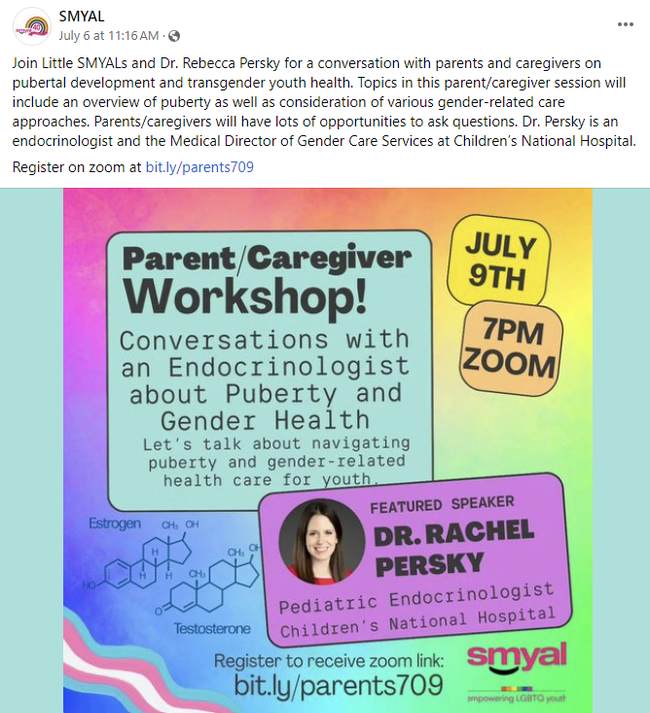by Mia Cathell
This is Part 2 of a multi-part investigative series.
Part 1 investigated the Sexual Minority Youth Assistance League (SMYAL)’s trail of government grants, leading to SMYAL’s taxpayer-funded LGBTQ youth program aimed at influencing kids as young as six-years-old to identify as “transgender.” This sequel follows the next (un)natural step in childhood “gender-transitioning,” providing a raw and intimately close peek under the hood of pediatric “gender care.” Meet the physicians who practice it, the parents who willfully sacrifice their children on the altar of gender ideology, and the activists who marshal them there.
WASHINGTON, DC — Pro tip: When medically mutilating your young son, you should consider actually allowing him to undergo puberty beforehand, thereby letting his penis grow to a sufficient length, long enough so that the surgeons have ample material to work with when it’s ultimately inverted into a neo-vagina. You see, the surgically constructed cavity ought to be of optimal depth, cavernous for coitus.
Those were the words, in essence, of Dr. Rebecca Wood Persky, a pediatric endocrinologist at Children’s National Hospital and the medical director of “Gender Care Services” there.
“Trans girls might have a change in their bottom-surgery option, if they choose to do bottom surgery, from being on puberty blockers,” she said, specifically. Of course, by “trans girls,” she means biological boys, and “bottom surgery” is a euphemistic expression for genital disfigurement.
Via penile-inversion vaginoplasty, Persky explained nonchalantly, the skin of the penis creates the vaginal canal, and the scrotum, after the testicles are taken out, becomes the labia majora.
“But that requires enough tissue there to make the vagina — to make a vagina with enough depth for sexual intercourse,” Persky cautioned.
“And so,” she continued, “if kids — or adolescents — are starting on puberty blockers at the very early stages of puberty and really not having penile growth or testicular growth or scrotal growth, then these options change, and you might have to do a more invasive option than the inversion vaginoplasty, which would have some more recovery time or complications. So that’s just an important thing to understand when making these decisions about timing and whether or not to start puberty blockers.”
Whereas in the case of “transgender boys” (i.e. biological girls) who take puberty-suppressing drugs early on, they may avoid “top surgery,” a.k.a. mastectomies, altogether, given there’s little to no natural breast development, Persky advised.
“This is something that they really wanted us to be sharing and talking about with families and patients before starting puberty blockers,” Persky, citing the conclusions of an American Academy of Pediatrics article that studied the “surgical implications” of pubertal suppression medication, disclosed during her hour-and-a-half lecture.
Listening intently to Persky’s medical guidance were parents of “transgender” children, tuning in virtually from various quarters around the DMV area, predominantly D.C. They — and I, joining via the publicly posted link — were attending a workshop on “Gender-Affirming Puberty,” presented by the Sexual Minority Youth Assistance League (SMYAL), a federally funded non-profit nestled on the outskirts of Capitol Hill.

Most of the caregivers, gathered over Zoom to learn about “navigating puberty” and exploring “gender-related care approaches,” have enrolled their children in Little SMYALs, the organization’s LGBTQ after-school program for kids in kindergarten through eighth grade. As Townhall’s initial exposé uncovered in disturbing detail, Little SMYALs conditions these children (ages six to 13) to identify as “transgender” — or, at least, induces a state of gender dysphoria — and coaches them through “transitioning” socially. This socialization process, which Little SMYALs ushers along within a matter of weeks, entails adopting a new name, using pronouns of the opposite sex, changing their clothes, cutting or growing out their hair, and even “coming out” in the classroom, all to assume this newfound “gender identity.”
And that’s how the program’s participants (well, their parents, acting on their behalf) ended up here, turning to medical means, either as a way of physically completing such outwardly changes or pausing puberty to give them (the children, ostensibly) time to decide what to do in the interim, that is while their bodies no longer naturally mature.